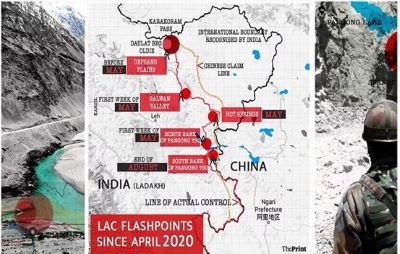Context-
At the Raisina Dialogue 2024, military leaders including India’s Chief of Defence Staff discussed the rise of gray-zone warfare, exemplified by actions in the South China Sea and along India's northern borders. Recently China’s aggressive response to the Newly elected Taiwan President Mr. Lai has escalated tensions using the same tactics.
Grey-Zone Warfare
Grey-zone warfare involves actions that fall between regular diplomacy and open conflict. In grey-zone warfare, adversaries employ tactics such as cyberattacks, economic coercion, and proxy conflicts to achieve their goals without directly engaging in open warfare. It blurs the lines between peace and conflict, posing significant challenges to international security and stability.
Elements of Grey-Zone Warfare
● Regular military drills and the display of advanced military capabilities serve to intimidate and demoralize the adversary.
Information and Cognitive Warfare
● Deploying propaganda and ideological narratives within enemy territory is a key element. By influencing public opinion and creating internal divisions.
● Leveraging economic dependencies to impose punitive measures adds another layer of coercion. By targeting key economic sectors, China aims to inflict economic pain and force political concessions.
China’s Grey Zone Tactics Against India
China engages in cyber operations targeting India's critical infrastructure and political systems. These activities include hacking, data theft, denial of service attacks, and spreading disinformation. For example, in 2022, the Indian government reported numerous cyber-attacks targeting its power transmission systems.
China employs information warfare by using propaganda, spreading rumors, and manipulating social media to create societal divisions and undermine trust within India. An instance of this was when intelligence services traced threatening messages sent to North Eastern Indian communities in Bengaluru back to China, as part of a broader campaign to influence internal Indian affairs.
China supports insurgent groups and non-state actors within India to create discord and deplete resources. This strategy was evident in the 1980s and 1990s when China backed various insurgent movements in India’s northeast, a tactic that reportedly continues today.
China uses economic coercion by imposing trade restrictions and leveraging economic influence to pressure India into policy changes without direct conflict. The Belt and Road Initiative exemplifies how China could use economic leverage for political and strategic gains.
Legal and Diplomatic Manoeuvring
China exploits legal loopholes, leverages international institutions, and manipulates alliances to undermine India’s international standing. For instance, China uses civilian fishing fleets to assert its presence in the South China Sea, circumventing international legal challenges.
China demonstrates military intimidation by showing force near borders or in contested regions to imply potential military escalation. A notable example is the massing of People’s Liberation Army (PLA) troops in the contested Galwan region in Ladakh.

India’s Counter Measures to Grey-Zone Warfare
India is enhancing military readiness along contentious borders by fortifying its defenses. For example, the country has deployed advanced surveillance systems, including UAVs (Unmanned Aerial Vehicles) and high-tech surveillance cameras, to monitor and respond to any adversarial movements.
India is engaging in defense collaborations with allies to bolster its strategic position. Notable examples include deepened defense ties with the United States through agreements such as the Logistics Exchange Memorandum of Agreement (LEMOA), the Communications Compatibility and Security Agreement (COMCASA), and the Basic Exchange and Cooperation Agreement (BECA). These agreements facilitate logistical support, secure communication, and the exchange of geospatial intelligence between the two militaries.
Participating in joint military exercises helps India enhance operational coordination with partner nations. Key examples are:
● Exercise Malabar: Initially a bilateral naval exercise between India and the US, it now includes Japan and Australia, reflecting the strategic convergence of the Quad countries. Malabar focuses on improving interoperability and understanding between the navies.
● Indo-Russian Exercise Indra: A bi-annual military exercise between India and Russia involving the Army, Navy, and Air Force, aimed at boosting military cooperation and interoperability.
India is expanding naval engagements to secure maritime domains. Significant initiatives include:
● Mission SAGAR (Security and Growth for All in the Region): Launched to ensure maritime security and stability by assisting countries in the Indian Ocean Region (IOR) with humanitarian assistance, disaster relief, and enhancing maritime cooperation.
● Indian Ocean Naval Symposium (IONS): India plays a leading role in IONS, a forum for the navies of the Indian Ocean littoral states, aimed at increasing maritime cooperation and addressing regional security challenges.
Defence Technology Collaborations
India is co-developing and co-producing defense technology and equipment with international partners. Participation in the Quad Alliance alongside the U.S., Australia, and Japan exemplifies efforts to address regional security challenges through technological collaboration.
Information Sharing
Improving intelligence sharing with allies is crucial for better understanding and responding to threats. An example is the establishment of the Information Fusion Centre – Indian Ocean Region (IFC-IOR), which enhances maritime security and information sharing among countries in the IOR. It serves as a hub for real-time maritime information sharing and improving regional maritime domain awareness.
Modernising Armed Forces
India is investing in new technology to modernize its military, making it capable of responding to a range of threats. For instance, the country is focusing on indigenous defense production through initiatives like the “Make in India” program. This includes the development of the Tejas Light Combat Aircraft (LCA), the Advanced Towed Artillery Gun System (ATAGS), and the Akash surface-to-air missile system. These efforts aim to reduce dependency on foreign imports and strengthen the domestic defense industry.
Conclusion
In response to China's grey-zone warfare tactics, India has strengthened border defenses, forged strategic partnerships, conducted joint military exercises, expanded naval cooperation, collaborated on defense technology, improved intelligence sharing, and modernized its armed forces. These comprehensive measures aim to counteract China's multi-faceted strategy, ensuring India's security and resilience against sustained non-military pressures.
|
Probable Questions for UPSC Mains Exam- 1. How has India leveraged strategic partnerships and joint military exercises to counter China's grey-zone warfare tactics? (10 Marks, 150 Words) 2. In what ways has India's focus on indigenous defense production and modernization of its armed forces enhanced its capability to respond to grey-zone threats from China? (15 Marks,250 Words) |
Source- The Hindu







